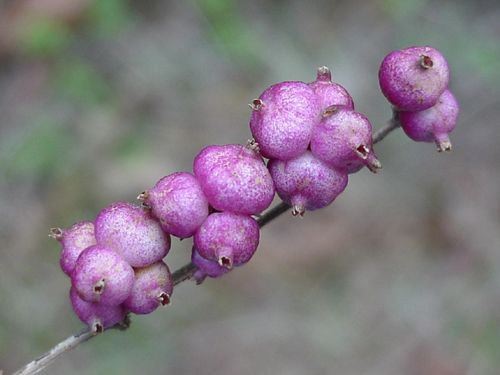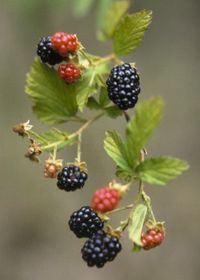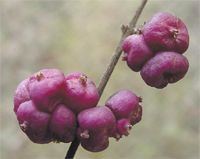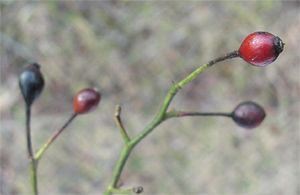|
|
|||
|
THIS WEEK at HILTON POND |
|
UNEATEN WILD FRUITS When you say the word "plant," the word "green" is probably in the back of your mind. After all, representatives of the Plantae--the Plant Kingdom--are by definition capable of photosynthesis because they contain chlorophyll, a green pigment. A few true plants--the ghostly white Indian Pipe, for example--lack chlorophyll and must parasitize a host or live off dead matter, but these are rare exceptions.  Chlorophyll has an obvious function--to help a plant convert sunlight into chemical energy--so it stands to reason that plants would be mostly green. But plants and their parts come in all sorts of other colors, from the yellow blossom of a Buttercup to the sanguine-colored flesh of the underground structure that gives Bloodroot its name, and then there are those colorful fruits that plants produce. Here at Hilton Pond Center, for example, we have crimson Flowering Dogwood berries, pinkish-orange Common Persimmons, purple Muscadines, and, of course, our favorites--black Blackberries (below left). Since plants devote so much energy to producing pigments, it must be that colors play important roles in the lives of the plants themselves. For example, brightly colored flowers or those with ultraviolet markings attract insect pollinators--an important process because for plants and their genes, propagation is the name of the game. By mid-March, wild fruits produced last year at Hilton Pond Center are usually long-gone. Japanese Honeysuckle's autumn crop of blue-black berries were among the first fruits eaten by birds and small mammals. Our local Virginia Opossums and Raccoons consumed the persimmon crop almost before it hit the ground. And "fruit predators" from Rusty Blackbirds to Eastern Chipmunks stripped every last berry from the dogwood trees. With all that action going on in late fall and early winter, we were surprised this week to find several plants still laden with fruit that matured several months ago. Perhaps the most obvious uneaten fruit was that of Coral-Berry, Symphoricarpos orbiculatus, a short, spindly stemmed, semi-woody shrub common to the Carolina Piedmont.
Even the shiny red fruit of Multiflora Rose, Rosa multiflora, still clings to the vine in mid-March at Hilton Pond Center (below right). Rose hips from other types of roses are famous as a source of vitamin C, but maybe the berries from this invasive Asian import don't suit the palates of our American bird species. It would probably take a good deal of laboratory analysis to determine the nutritional value of fruit from Coral-Berry, Horse Nettle, and Multiflora Rose, If you enjoy "This Week at Hilton Pond," please help Support Hilton Pond Center for Piedmont Natural History. It's painless, and YOU can make a difference! You may wish to consult our Index of all nature topics covered since February 2000. |

 Brightly colored fruit provides a similar function in that visually obvious berries get eaten by animals that transport seeds to more distant locales.
Brightly colored fruit provides a similar function in that visually obvious berries get eaten by animals that transport seeds to more distant locales. This species typically produces fruits in various shades of red, but those at Hilton Pond Center bear distinctive lavender-pink berries that persist all winter long (see photos at top and at right). To the human eye, their bright color stands out in sharp contrast to the tans and browns of dormant winter vegetation, so we've often wondered how it is that these berries go uneaten--especially since Coral-Berry is in the same family (Caprifoliaceae) as the delectable Japanese Honeysuckle. Could it be that birds--whose colorful plumages lead us to conclude they must have good color vision--happen not to be able to see the Coral-Berry's unusual lavender-pink hue?
This species typically produces fruits in various shades of red, but those at Hilton Pond Center bear distinctive lavender-pink berries that persist all winter long (see photos at top and at right). To the human eye, their bright color stands out in sharp contrast to the tans and browns of dormant winter vegetation, so we've often wondered how it is that these berries go uneaten--especially since Coral-Berry is in the same family (Caprifoliaceae) as the delectable Japanese Honeysuckle. Could it be that birds--whose colorful plumages lead us to conclude they must have good color vision--happen not to be able to see the Coral-Berry's unusual lavender-pink hue? And how about the globular yellow-orange fruits of Horse Nettle, Solanum carolinense, which have been ripe for picking all winter long? Surely these half-inch tomato-like berries (left photo) are easily seen by wildlife. Perhaps the fact that Horse Nettle is in the Deadly Nightshade Family (Solanaceae) explains why these particular fruits have gone untouched.
And how about the globular yellow-orange fruits of Horse Nettle, Solanum carolinense, which have been ripe for picking all winter long? Surely these half-inch tomato-like berries (left photo) are easily seen by wildlife. Perhaps the fact that Horse Nettle is in the Deadly Nightshade Family (Solanaceae) explains why these particular fruits have gone untouched. but our guess is that local fauna already tell us that berries from these three plants either are not worth the effort, or that they just plain taste bad. In either case, the plants in question have tied up a lot of energy in producing seed-bearing structures that aren't being consumed and transported by wildlife, so their brightly colored but uneaten fruits are a mystery to us--not the first time that a curious natural phenomenon has gone unexplained at Hilton Pond Center.
but our guess is that local fauna already tell us that berries from these three plants either are not worth the effort, or that they just plain taste bad. In either case, the plants in question have tied up a lot of energy in producing seed-bearing structures that aren't being consumed and transported by wildlife, so their brightly colored but uneaten fruits are a mystery to us--not the first time that a curious natural phenomenon has gone unexplained at Hilton Pond Center.
